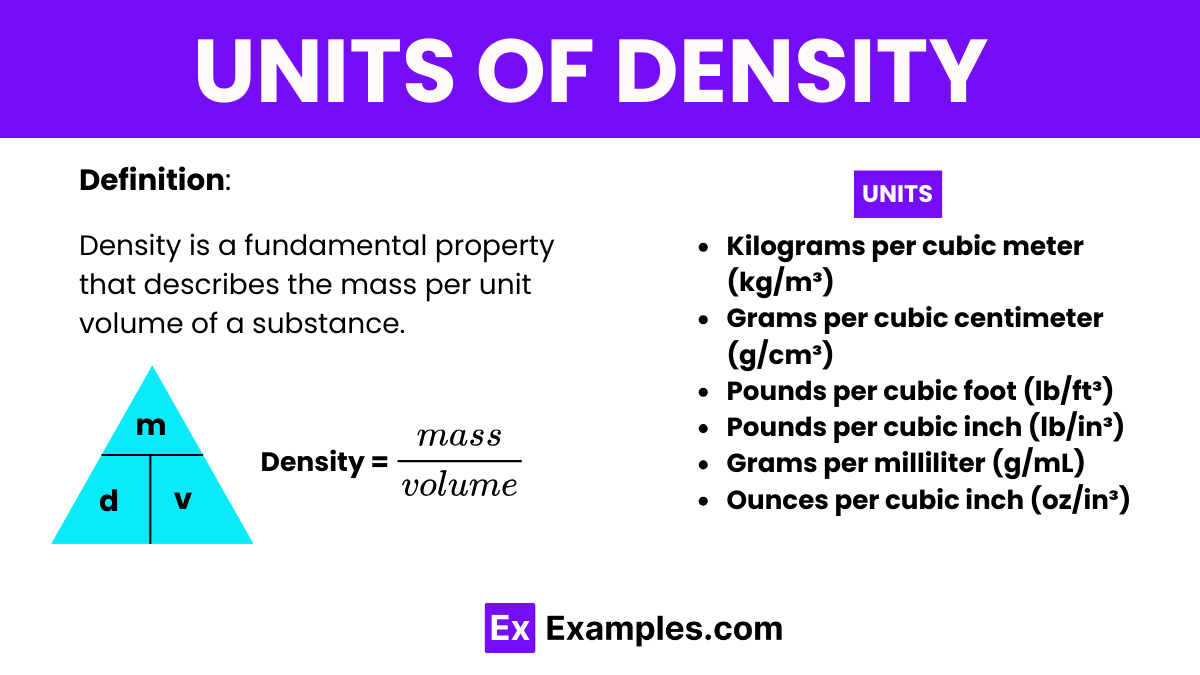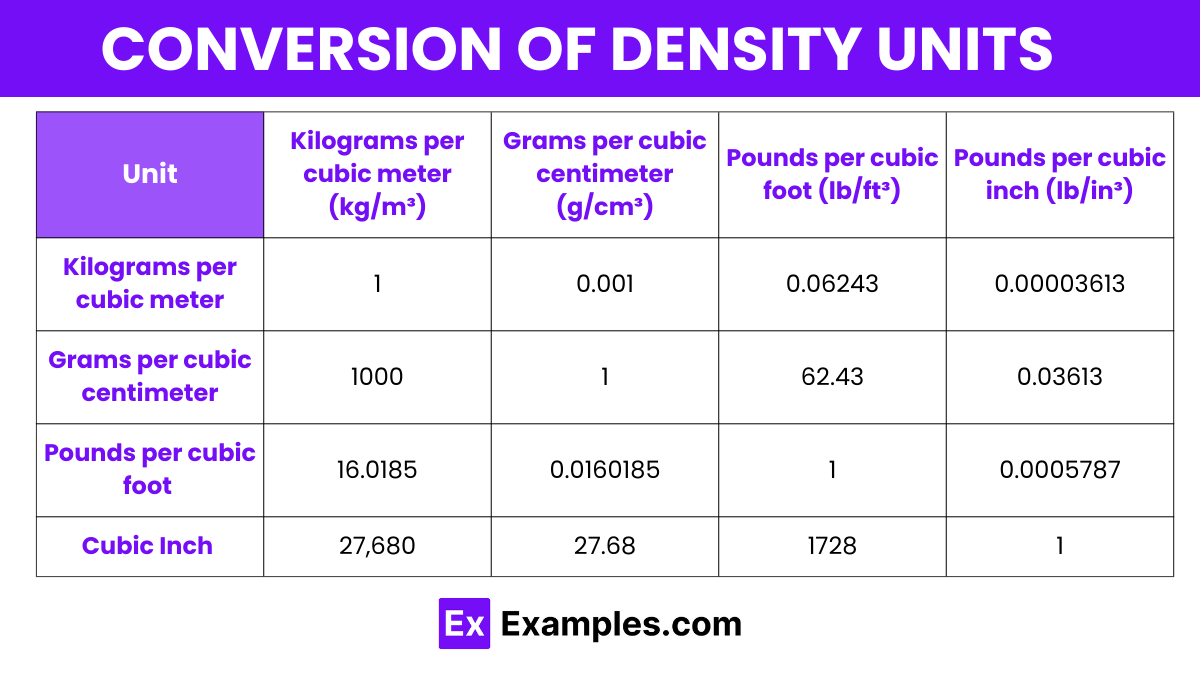What is the SI unit of density?
g/cm³
kg/m³
lb/ft³
mg/L


Density is a fundamental property that describes the mass per unit volume of a substance. This measurement is crucial in various scientific and industrial fields, allowing us to understand the compactness of materials and how they will interact with their environments.
Transitioning to other units, grams per cubic centimeter (g/cm³) offer precision for smaller quantities, common in laboratory settings for their ease of use in calculations involving smaller samples.
The SI unit of density is the kilogram per cubic meter (kg/m³). This unit comprehensively measures the mass of a material contained within one cubic meter of space. Widely adopted across various scientific and engineering disciplines, kilograms per cubic meter provide a universal standard, facilitating precise and consistent calculations of material compactness and concentration.
The CGS (centimeter-gram-second) unit of density is grams per cubic centimeter (g/cm³). This unit effectively measures the mass of a substance contained within a cubic centimeter of volume. It is particularly useful in fields such as chemistry and materials science, where precise density measurements are essential for experiments and product formulations.
| Unit | Symbol |
|---|---|
| Kilogram per cubic meter | kg/m³ |
| Gram per cubic centimeter | g/cm³ |
| Pound per cubic foot | lb/ft³ |
| Pound per cubic inch | lb/in³ |
| Ounce per cubic inch | oz/in³ |
The kilogram per cubic meter is the SI unit of density, representing the mass contained within one cubic meter of volume. It is universally used in science and engineering to quantify the density of substances, from gases to solids.
A gram per cubic centimeter is a unit of density commonly used in chemistry and material sciences. It measures the mass of a substance in a volume of one cubic centimeter, providing a convenient scale for precise measurements.
The pound per cubic foot is used primarily in the United States for industrial and commercial applications. It defines the mass of a substance per cubic foot of volume, commonly used in the building materials industry.
This unit is extremely dense, measuring the mass of material per cubic inch. It is often used in engineering fields to describe the density of metals and other heavy materials.
An ounce per cubic inch is used to express the density of smaller, more precious materials, particularly in manufacturing and jewelry industries. It provides a fine scale suitable for detailed work where precision is paramount.

Here’s a conversion table for density, illustrating how to convert between common units of density such as kilograms per cubic meter (kg/m³), grams per cubic centimeter (g/cm³), pounds per cubic foot (lb/ft³), and pounds per cubic inch (lb/in³):
| Unit | Kilograms per cubic meter (kg/m³) | Grams per cubic centimeter (g/cm³) | Pounds per cubic foot (lb/ft³) | Pounds per cubic inch (lb/in³) |
|---|---|---|---|---|
| Kilograms per cubic meter (kg/m³) | 1 | 0.001 | 0.06243 | 0.00003613 |
| Grams per cubic centimeter (g/cm³) | 1000 | 1 | 62.43 | 0.03613 |
| Pounds per cubic foot (lb/ft³) | 16.0185 | 0.0160185 | 1 | 0.0005787 |
| Pounds per cubic inch (lb/in³) | 27,680 | 27.68 | 1728 | 1 |
Kilograms per Cubic Meter to Pounds per Cubic Inch
Yes, grams per milliliter (g/mL) is indeed a unit of density, commonly used to express the mass per volume of liquids in laboratory settings.
A commonly used unit of density is kilograms per cubic meter (kg/m³), especially for solids and gases in scientific and engineering contexts.
No, g/mL³ is not a recognized unit of density. Density is typically expressed as mass per unit volume, not volume cubed.
Text prompt
Add Tone
10 Examples of Public speaking
20 Examples of Gas lighting
What is the SI unit of density?
g/cm³
kg/m³
lb/ft³
mg/L
Which of the following units is commonly used to express the density of liquids?
kg/m³
g/L
g/cm³
lb/in³
Convert 1 g/cm³ to kg/m³.
1000 kg/m³
10 kg/m³
0.001 kg/m³
100 kg/m³
Convert 500 kg/m³ to g/cm³.
0.5 g/cm³
5 g/cm³
50 g/cm³
0.05 g/cm³
Which of the following is a unit of density in the cgs (centimeter-gram-second) system?
kg/m³
g/cm³
lb/in³
mg/L
How is the density of gases typically expressed in scientific contexts?
g/cm³
kg/m³
lb/in³
mg/L
If a material has a density of 500 kg/m³, what is its density in g/cm³?
0.5 g/cm³
5 g/cm³
50 g/cm³
5000 g/cm³
Which unit is not commonly used to measure density?
g/cm³
kg/m³
lb/ft³
m/s
The density of water at 4°C is often taken as a standard. What is its value in kg/m³?
1 kg/m³
100 kg/m³
1000 kg/m³
10,000 kg/m³
What is the density of a substance if 1 liter of it has a mass of 1 kilogram?
1 kg/m³
10 kg/m³
100 kg/m³
1000 kg/m³
Before you leave, take our quick quiz to enhance your learning!

